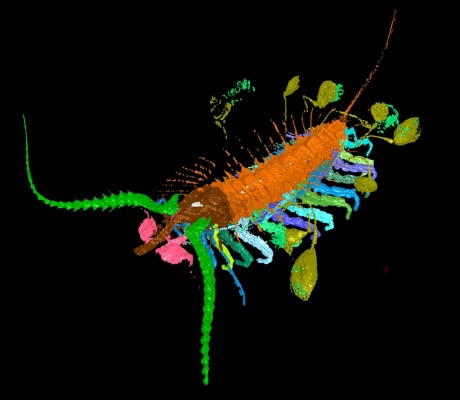Scientists puzzled by prehistoric creature that hauled its offspring 'like kites'

A fossil of a bizarre extinct arthropod that is thought to have carried its young in capsules attached to its body like kites has been discovered by scientists in Herefordshire. The species, dubbed the "kite runner", roamed the Earth's oceans 430 million years ago. It grew to less than half an inch long, had many legs and was eyeless.
Analysis of a tiny fossil of the shrimp-like creature recovered from a sedimentary deposit in Herefordshire revealed 10 offspring, at different stages of development, connected to the adult by miniscule threads.
Palaeontologists say the behaviour of hauling offspring like kites is without precedent in the animal kingdom. The findings are detailed in the journal Proceedings of the National Academy of Sciences.
Unique habit
"Modern crustaceans employ a variety of strategies to protect their eggs and embryos from predators — attaching them to limbs, holding them under the carapace, or enclosing them within a special pouch until they are old enough to be released — but this example is unique," said professor Derek Briggs from Yale University.
"Nothing is known today that attaches the young by threads to its upper surface."
The species has been given the scientific name Aquilonifer spinosus ("aquila" means kite and "fer" means carry).
Researchers considered alternate explanations for the "kites" attached to the adult, including the possibility that they were parasites feeding off their host.
ESE's Dr Mark Sutton examines how an ancient 'Kite Runner' kept its young on a tether https://t.co/AViATt29u0
— Imperial RSM (@ImperialRSM) April 4, 2016
"But the closer we looked the less likely that seemed," said co-author Dr Mark Sutton from the Department of Earth Science and Engineering at Imperial College London.
"The most telling argument for the adult wanting them to be there is that the creature has large and flexible appendages, which could certainly have removed the 'kites' if it wanted to.
"If it wanted them to be there, the only real possibility is that they were its young."
Researchers believe Aquilonifer lived on the sea floor with a variety of other animals such as sponges, brachiopods, worms, snails and various shrimp-like creatures.
The capsules containing its young looked like "flattened lemons", they said.
Prof Briggs added: "As the parent moved around, the juveniles would have looked like decorations or kites attached to it.
"It shows that arthropods evolved a variety of brooding strategies beyond those around today — perhaps this strategy was less successful and became extinct."
© Copyright IBTimes 2025. All rights reserved.






















